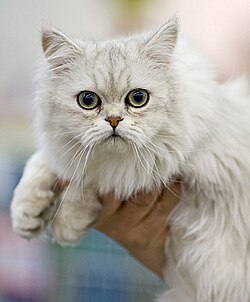A request that this article title be changed to Tiffanie is under discussion . Please do not move this article until the discussion is closed. |
This article appears to contradict the article List of experimental cat breeds#Tiffanie .(January 2024) |
| Tiffanie | |
|---|---|
 A black silver male Tiffanie | |
| Other names | Asian Semi-longhair, Asian Longhair, Burmilla Longhair |
| Origin | United Kingdom |
| Breed standards | |
| WCF | standard |
| ACF | standard |
| GCCF | standard |
| LOOF | standard |
| SACC | [https://en.woc.center/articles/standards-tif/ WOC standard, ANCATS standard standard] |
| Notes | |
In ACF and ANCATS only in silver or golden tipped and shaded. | |
| Domestic cat (Felis catus) | |
The Tiffanie [1] [2] is a cat breed similar to the Asian Shorthair except it has semi-long fur length. The breed belongs to the Asian Group [3] [4] [5] and is generally recognised in any of the Asian Shorthair or Burmese colours and patterns. Like the other cats in the Asian Group, the breed was developed during the 1980s in the United Kingdom by crossbreeding a Persian Chinchilla and a Burmese. [2] [3] [4] [5] [6]
Contents
In cat registries that recognise the breed, it is officially registered under the name Tiffanie [1] [7] [8] or within the Asian Group as Tiffanie [9] or Asian Longhair. [10] In some registries the colouration is restricted to silver or golden tipped or shaded, and the breed is registered as Burmilla Longhair [11] or Australian Tiffanie. [12] [13] Among the cat fancy the breed is also known as the Asian Semi-longhair.
The Tiffanie is often confused with the now extinct and unrelated Chantilly-Tiffany , or Foreign Longhair, a longhaired North American breed originating from chocolate-brown cats of unknown origin. [2] Similarly, the Tiffany in the NZCF (New Zealand) refers to a Burmese longhair. [14] [15] [16]


